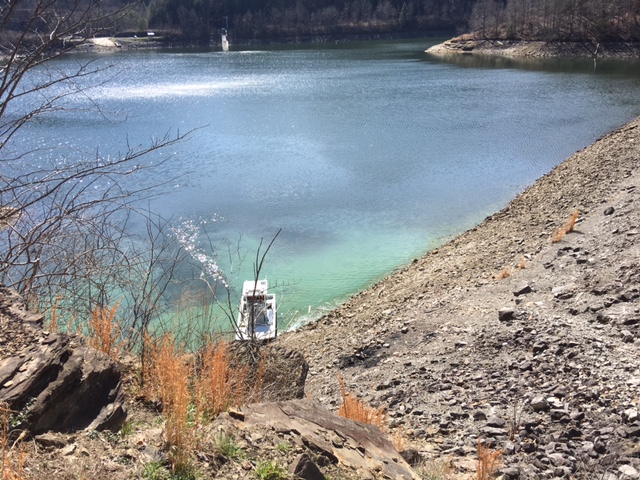HAB Hotline: 888-238-6154
FREQUENTLY ASKED QUESTIONS (FAQs): John W. Flannagan – Algae Bloom Investigation
Posted: March 19, 2017
Officials determined the algae bloom which occurred from late February through early March 2017 in the Flannagan Reservoir did not pose a human health risk.
On Feb. 28, the U.S. Army Corps of Engineers (USACE) reported to the Virginia Department of Health (VDH) a bloom of blue-green algae in John W. Flannagan Reservoir in Dickenson County.

The reservoir water is withdrawn and treated to provide a source of drinking water for approximately 37,000 customers in Buchanan and Dickson Counties, and small parts of Wise and Tazewell counties, and is a popular fishing and recreational destination.
The Virginia Department of Environmental Quality (VDEQ), VDH, USACE, Old Dominion University (ODU) and other organizations have conducted several tests on the reservoir water to determine the safety for recreational uses, in addition to pre and post-treated drinking water within the water treatment plant to ensure the safety of the treated drinking water. The tests assessed the presence and abundance of blue-green algae species in addition to evaluating potential toxins and health risks associated with them.
Photo Credit: USACE – February 24, 2017
Test results indicated that while several cyanobacteria species capable of producing toxins were present within the reservoir, they were not present at levels which posed a risk of toxin production. Toxin concentrations were well below health advisory levels for both drinking water and recreational uses.
Very cold temperatures in the first and second week of March are believed to have ended the bloom event.
VDEQ, VDH, USACE, and ODU, and the local water treatment plant will conduct observations of the reservoir as temperatures warm in the coming weeks. Samples will be collected and analyzed should the bloom return. Results of analyses have been posted on the Algal Bloom map. Should further observations or tests indicate a human health risk, a public notification and health advisories may be issued.
You may see this sign posted at access points to the Pound, Cranes Nest, and Russell Fork Rivers in addition to along the John W. Flannagan Reservoir.
Be Aware of Algae Blooms – The purpose of the sign is to raise awareness of algae blooms and to encourage citizens to report blooms when they are observed.
Blue-green algae are microorganisms which are naturally occurring in fresh and brackish waters. Some species have the potential to produce toxins when they accumulate at high numbers. A bloom becomes visible at high numbers and may form a ‘scum’ or ‘clumpy glops’ on the water surface which may appear green or reddish-brown in fresh water, depending on the types of algae present. Blooms can become harmful when they produce a toxin, which if ingested may affect the nervous system or the liver. Some toxins may also cause skin irritation such as a rash, tingling, or numbness. In the environment, algae blooms may cause fish kills or wildlife mortality. Algae blooms may be indicative of water pollution, such as nutrients from discharges or non-point source runoff from agriculture or residential fertilizer applications.
Be aware of algae blooms and stay safe while recreating by practicing the following tips:
• Never drink untreated water. Boiling water where there is a harmful algae bloom will not destroy toxins which may be present.
• Do not let children, pets, or livestock get into or drink waters with an algae bloom.
• Avoid direct contact with water that has unusual color or where blue-green bacteria have been identified. This means no swimming, wading, paddling, diving, or water-skiing in affected waters.
• If skin is exposed to bloom water, wash off with fresh water. Use rubber gloves if contact with affected waters must be made.
• If you are exposed to a bloom and believe you may be experiencing health effects, consult your local health care provider.
• People that are prone to respiratory allergies or asthma should avoid areas with algae blooms.
• It is safe to consume properly cooked fish fillets dressed from fish caught from waters with an algae bloom. Discard the carcass and guts and thoroughly wash skin and surfaces that come into contact with the fish.
• Report algae blooms, fish kills, or health effects which are believed to be a result of exposure to an algae bloom on the 24/7 HAB Hotline at 888-238-6154.
The Virginia HAB Task Force has conducted surveillance and response of fresh and marine waterbodies for nearly 20 years within the Commonwealth in recreational waters, shellfish growing areas, and drinking water sources. To learn more about HABs, to review frequently asked questions, and for printable brochures or other materials and information, please visit www.HarmfulAlgaeVA.com.
For information on federal policy and guidance, please visit the EPA CyanoHAB website and the CDC HAB-Associated Illness website.
